I like herbs. As in: very much. I have a lot of varying packages, boxes, glasses and tins in my kitchen. They are sitting there on their shelfes, filled to the brim with exotic, delicious, pungent, hot sour or spicy flavours. Waiting for me to let them do their magic. 😉
Don’t get me wrong: I like simple, down-to-earth dishes, which are not too pompous. But I like spices and I like it to make my own spice blends as staples.
To celebrate my new blog I chose to show you a beautiful spice blend from the thirteenth century Syrian cookbook (the author is unknown) “Scents and Flavors“* (“Al-Wusla ila ‘l-Habeeb”) in the translation von Charles Perry. (I’m afraid you will stumble a lot over Charles Perry in the coming months, because he is one of the leading experts in the domain I plan to invade with my work. 😅 He is a major contributor to the Oxford Symposium on Food and Cookery (I hope I can participate somtime in the future) and translated two of my most loved books – the more posh “Scents and Flavors” and “A Baghdad Cookery Book“*, the Kitâb al Tabîkh (The Book of Dishes) from Al Baghdadi.)
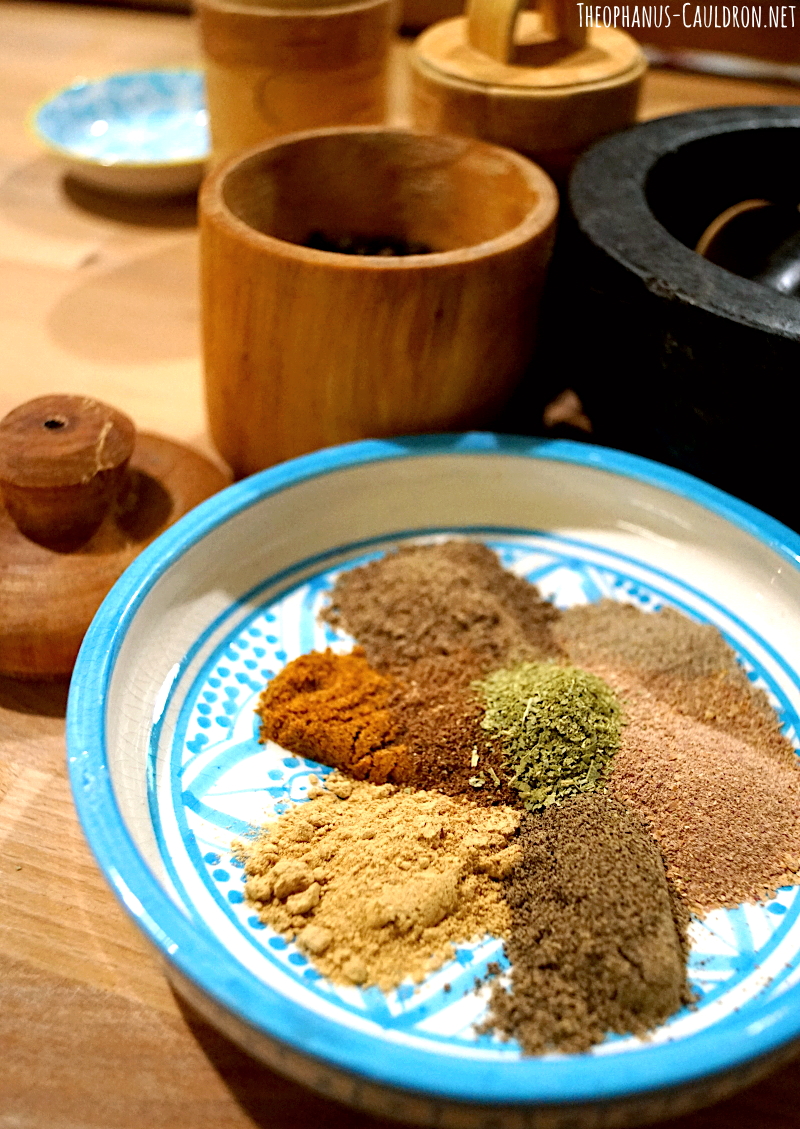
Medieval middle eastern spice blend
When you read the recipes in these old books, you find sometimes in the list of ingredients the description “mixed spices”. First I just wondered and tought that I might substitute this ominous mixed spices with my version of a wonderful spicy herb salt I made following the instructions in the Kitâb al Tabîkh. But then I found Charles Perrys insights in the glossary:
a spice mixture which probably varied by time and place. The name atraf al-tib, ‘sides of scent’, referred to the paper packets in which the spices were sold in markets. […] (Scents and Flavors, p. 155, glossary: mixed spices)
He points his readers to two recipes in Scents and Flavors. One (chapter 4.4.), which is very rich and with a lot of expensive ingedrients. And another one (c. 2.14), which is more restrained. He concludes that not all spices were obligatory and that the basic ingredrients would have been “merely ginger, cardamom and a bit of clove”. The unknown author of Scents and Flavors would use the spice blend in sweet beverages (as in oxymel for example) or in savoury dishes like chicken meatballs (chapter 5.17), persian turnips (c. 8.11) or fried cucumbers (c. 8.81).
According to requirements the used herbs could be a blend of “spikenard, betel nut, bay leaf, nutmeg, mace, cardamom, clove, rose hips, ash tree fruits, long pepper, ginger and black pepper, all pounded seprately.” (c. 4.4)
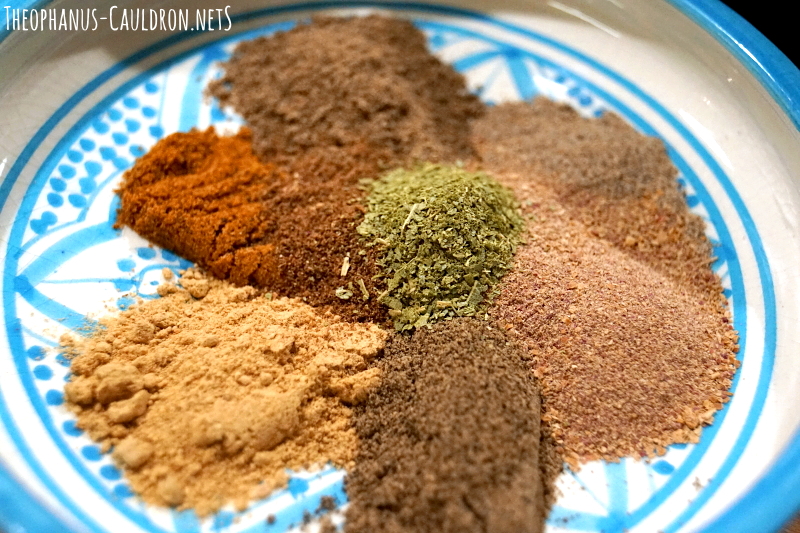
I think Atraf al-tib was something like the more modern spice blend arabic Baharat (which translates simple to “spices”): You bought it by your favourite spice merchant or made your special version in your own kitchen. For my version I used all the basic ingedrients and added the herbs which I personally like a lot and had at hand. (At this point I made – based on my experiences with the Arabic kitchen – the wrong presumption and used rose petals instead of the more unsual rose hips. As you can see, I’m not the only one wondering if rose hips are really correct. But in hindsight: The more I think about it, the more it makes sort of sense. I’ve never seen rose hips in Arabic recipes before, but in germany they are used for “Hiffenmark” (a veeery special kind of jam) and they are often found in teas. They are really rich on vitamin c and taste very sour. I think they have a little similarity to sumak? So.. just try my fragrant version or substitute with 1 tsp of sumak or go forward with rose hips. I surely will try the latter and add my findings here. Sigh.. I’m not happy about this mistake, especially not in my first post. But I’m not ashamed. This is natural and part of the process of learning, self reflecting on assumptions and in it’s essence: research. )
Edit 11.10.2020:
After publishing this article I spoke with Urtatim Al-Qurtubiyya (SCA-name) and she pointed out, that other translators of this text – like Nawal Nasrallah, who wrote “Annals of the Caliphs’ Kitchens“* (translation of Al-Warraqs’s tenth century cookbook) and who is orginally from Iraqi – translates the ingredient as rose buds. Nasrallah also wrote “Delights From the Garden of Eden“*, a cookbook about the history or Iraqi Cuisine. And in the Glossary, filed under “Baharat” I found this:
Baharat is used throughout the Middle East, but each region, or even each household, hast its own favorite blend of spices. […] Otherwise, during the pre-Ottoman period, spice mixes in the medieval Muslim eastern and western Arab world were calles atraf al-teeb, afwah al-teeb . and nawafih al-teeb (literally ‘blend of aromatic spices’). […]
We are equally fortunate that the thirteenth-century Aleppan cookbook Al-Wusla ila ‘I-Habeeb volunteers a list of spices used in the famous blend called atraf al-teeb/afwah al-teeb. They are: […] rose buds, […] (Delights from the Garden of Eden, p. 414, glossary: Baharat)
So – phew! It’s really good to see that I wasn’t in the wrong and that I’m, in terms of the Baharat, on the same page with Nawal Nasrallah.
I don’t ground big amounts of spices in a mortar anymore – at least not when I am at home in my modern kitchen. 😁 I use an electric coffee grinder* with a detachable cup. Sorry to disappoint you – but your wrists will be thankful.
I strongly recommend to grind the spices fresh, it’s just a better aroma. The fragrance of freshly crushed cardamom seed is just matchless.
I used this mix of spices for vegetable dishes and dressings and – as a marinade with butter – for broiled chicken. As you can see – it turned out beautifully.
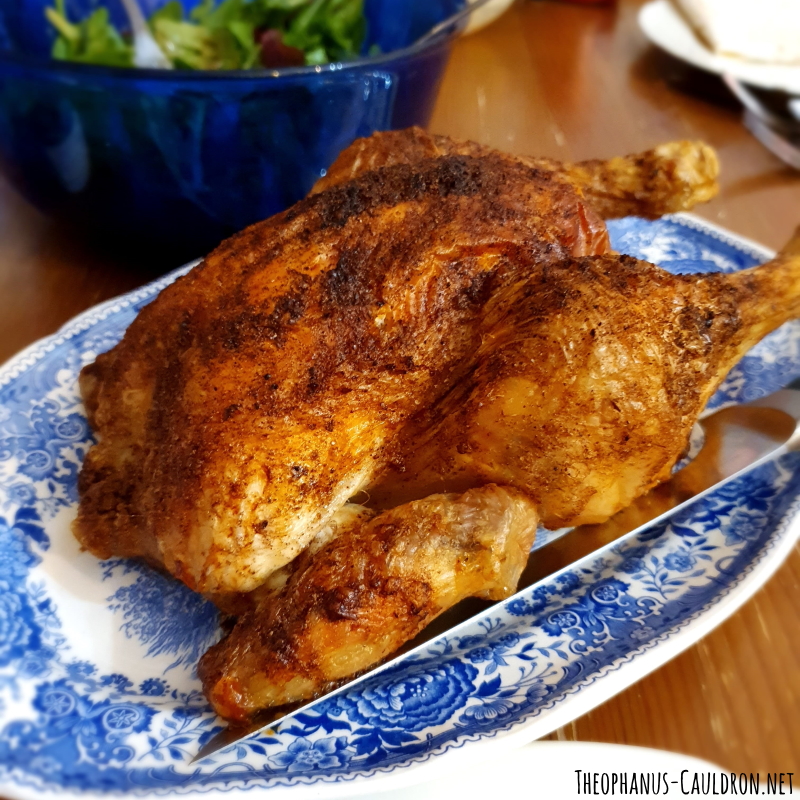
Recipe for Atraf al-tib
2 tsp dried rose petals (finely ground) (Charles Perry: rose hips / Nawal Nasrallah: rose buds*)
1 tsp green cardamom seeds (finely ground)
1 tsp dried ginger (finely ground)
1 tsp black pepper corns (finely ground)
1 tsp long pepper (finely ground)
3/4 tsp Mace (finely ground)
10 cloves (finely ground)
3 bay leafs (finely ground)
Preparation
After grounding the herbs, put everything into a small bowl and mix it thoroughly.
Fill the mixture in a well shutting jar. That’s it.
Literature:
Scents and Flavors*: A Syrian Cookbook, Perry, Charles (translator), New York University Press, New York 2020, ISBN: 978-1479800810
Delights From the Garden of Eden* (abbv., second edition): A Cookbook and History of the Iraqi, Nasrallah, Nawal, Equinox Publishing Ltd, Sheffield, 2018, ISBN: 978-1781798836
* Ad/Werbung. As an Amazon Associate I earn from qualifying purchases. Afiliate-Links zu Amazon. Bei einem Kauf hierüber erhalte ich eine Vergütung.

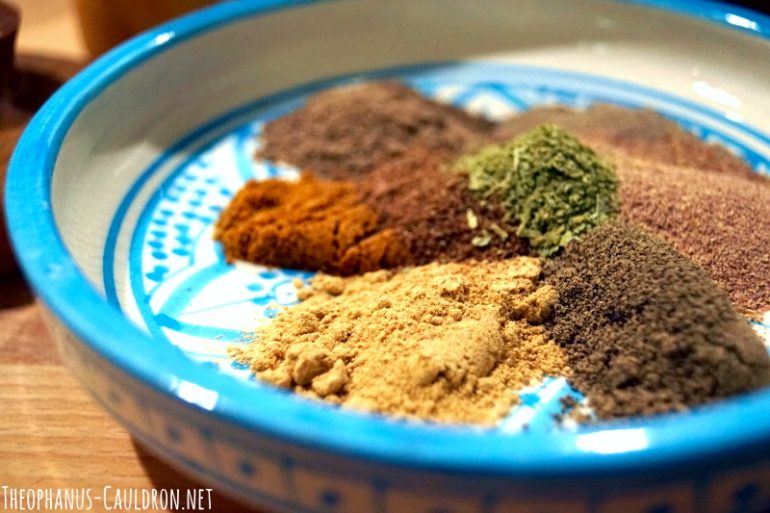
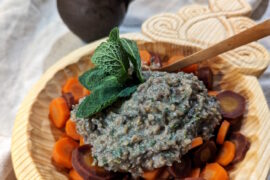
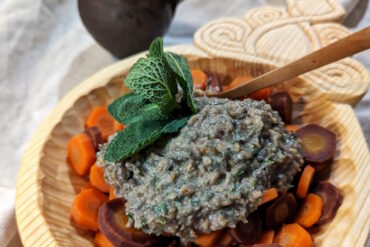
So, am I the first to comment?
Congratulations to your new blog! And I like your recipe. I am looking forward to your next posts.
Best wishes, Sus
@Sus – Yes – you are the first one. 🙂 Thanks!
I recently was introduced to this book so was very interested to read your blog. Nicely done! I think long pepper would be very difficult to find where I live. Can you recommend a substitute? Looking forward to more blog posts 🙂
@Kimberley – Thank you! 😊 Unfortunately I have no idea how to substitute long pepper. It’s such an unique, spicy, peppery-floraly-fruity taste that I would recommend to try to find it, if you are really interested in this spice. Everybody tastes spices a bit different, my brain links long pepper with references to hyacinths, pepper and red vine.
It is nothing you can buy in a regular super market, I stumbled over it 10 years ago at at food fair and fell in love. I really like to use it pure for my cooking and order it online at spice traders. But you have always the option to just leave it out.
Thank you! I was searching online for this recipe. I’m in Tasmania and love spices. I’m going to make it this week.
@Pil – Great! Would be lovely to hear from you what you have cooked with it. I love the thought of modern dishes with the flavours of ancient times. 🙂
You mentioned rose hip jam, and it indeed has a very nice, slightly acidic flavour. However, it is laborious to prepare. Collect the rose hips in late autumn, wash and cut them open. Discard the seeds and keep only the red part (be careful, the fine hairs that surround the seed itch like hell). Steam the hips with a little water and then pass through a sieve to separate the translucent, leathery peels (which are also discarded) from the marrow that is actually used to make jam by boiling it 4 min with preserving sugar. I prefer the one with more pectin, so that you can use 1 part of sugar with 2 parts of fruit. Fill into sterile jars and seal.
@Engelbert – Thanks for the recipe. 🙂 I’m from Germany and I made Hiffenmark for myself at one time in my life. But it wasn’t really good. 😅
Oct. 2024; I ran accross Atraf al tib for the first time in a 50 year interest in spices. It was a reference from a 13th century middle eastern book I started to read. Wanted to know more because it seemed widely used back then and is abscent today. Thank you kindly for providing more information, trying to find a vendor now.
@Kelly – My pleasure! Wish you good luck with the spice hunt! ☺